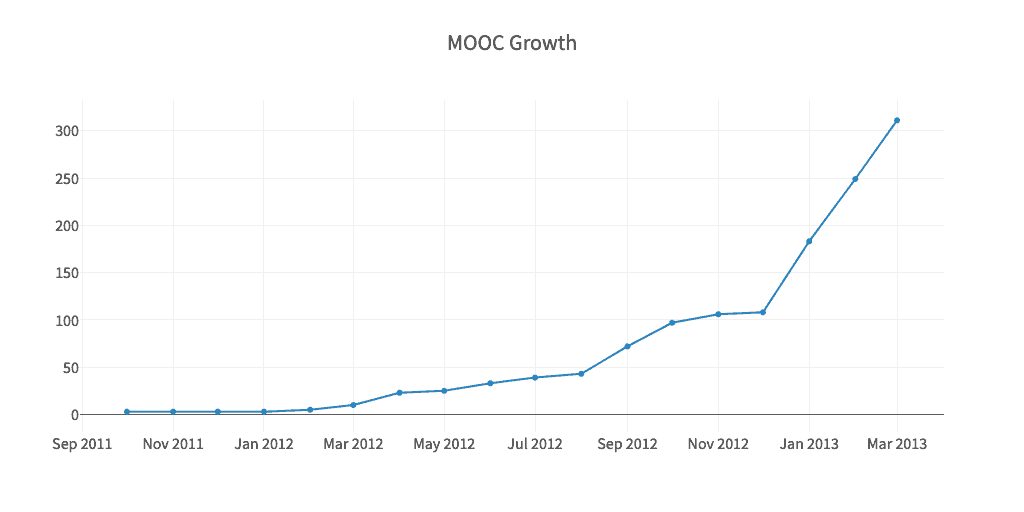The MOOC Juggernaut: One Year Later
It’s been a year since the first iteration of free Massively Open Online Courses (MOOCs) from Stanford Faculty went live.

It’s been a year since the first iteration of free Massively Open Online Courses (MOOCs) from Stanford Faculty went live. On 10th October, 2011 the following courses were offered for the first time:
1) ‘Introduction to Artificial Intelligence (AI)’ – Sebastian Thrun and Peter Norving (now Udacity)
2) ‘Machine Learning’ – Andrew Ng (now Coursera)
3) ‘Introduction to Databases’ – Jennifer Widom (now Coursera)
These courses were extremely popular with each one attracting over and around 100,000+ students and they spawned two start ups – Coursera and Udacity. Since then a number of universities/initiatives have joined in and the total number of courses announced has exploded to around 250. By the end of October over 100 courses would have begun.
Initiatives
Coursera, Udacity, and edX are the three major players with Coursera being the biggest in terms of sheer number of courses. So far, Coursera has announced 198 courses with around 60 courses to have started by the end of October. Coursera and Udacity are for-profit, while edX is a non-profit organization.
Like Coursera, edX benefits from university partnerships which could potentially allow them to add newer courses faster. As of the writing of this post, Coursera has 33 university partners, while edX recently announced the addition of the University of Texas System to increase the number of university partners to four. Although, Udacity has no official university partners, they have offered courses such as Reddit co-founder Steve Huffman’s, ‘How to Build a blog’ and Andy Brown’s ‘Introduction to Physics’ from non-faculty members.
Another Stanford initiative, Venture Lab, has a different take on MOOCs and allows students to form teams and work on group projects.
Student Numbers
Coursera announced that they have crossed one million enrollments across 196 countries.
Udacity founder, Sebastian Thrun aims to enroll 500,000 students and Udacity might not be far from that goal. Last month, they announced that 200,000 students have completed the first programming challenge for Dave Evans’ ‘Introduction to Computer Science’ (CS101). Currently, Udacity lists over 110,000 active students on its homepage.
155,000 students enrolled for Massachusetts Institute of Technology’s MIT’ prototype course ‘6.002x – Circuits & Electronics’. MITx later became part of edX.
Trends
One interesting trend that can be seen is companies offering MOOCs to increase the adoption of their tools/technologies. We have seem this with 10gen offering Mongo courses and to a lesser extent with Coursera’s ‘Functional Programming in Scala’ taught by Martin Odersky, creator of Scala and chairman of Typeface, a company providing commercial support, training, and services for Scala. Recently, Udacity also announced that they are launching four new courses early 2013 and have three more in the pipeline in partnership with companies like Google, NVIDIA, Microsoft, Autodesk, Cadence, and Wolfram.
Diversity of Courses
The initial batch of courses offered were overwhelmingly computer science/engineering courses. But Coursera has mangaged to add quite a bit of diversity with courses in economics & finance, humanities & social sciences, medicine among others. Despite that, over half of the courses are from a computer science background.







Steven Swigart
Great post, and you have been covering it from day one. Love the charts, how were they done? Adds nice visual context.
Alastair
Look like standard Excel chart templates to me…?
classcentral
http://www.highcharts.com/
William Lue
Just picked up the topic from a friend in the know and find the development of udacity very encouraging. Living on the other side of the Pacific, the world’s Chinese communities will most certainly be more than ready to take advantage of MOOC-cum-udacity. Wouldn’t it be even better if a Chinese version can be created for synergy ? Fingers crossed.
HEMADRI PRASAD RAJU
I also feel better if those courses are offered in Indian languages. Many Indians will be benefited because it would be understood well.
The Stanford team behind Venture Lab, founds a company NovoEd to offer collaborative MOOCs by Class Central blog
[…] landscape for online education is growing at a rapid rate. This can be overwhelmingly credited to Stanford Professors, who are responsible for founding both […]
Dr.A.VANI
Really amazing idea.It helps a lot for students and faculty.Introduces the courses in Coursera in Indian languages.
Thank you